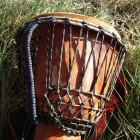The following exploration is an excerpt from Flutes Jam: A Guide to Improvisation. In this section I compare the rhythmic pattern for the Brazilian rhythm Reunion, with the intervals for the Hindu scale I’ve been enjoying on flute.
At the last samba practice, the band leader called for the “Six Eight” rhythm. Lately we’ve been learning an arrangement called Bankoma 6/8 (Haffner/DeMiranda, Blocos Afro). The woodblocks are complemented in our arrangement by a bell playing just the low notes: L – L – L L – L – L – L —the well-known short bell pattern, which also indicates the intervals of the major diatonic scale.
Bankoma 6/8
|
|
1 |
. |
. |
2 |
. |
. |
3 |
. |
. |
4 |
. |
. |
|
surdo 1 |
o |
|
|
O |
|
|
o |
|
|
O |
|
|
|
surdo 2 |
o |
o |
o |
|
o |
o |
o |
|
O |
O |
O |
O |
|
> |
O |
|
|
|
|
|
|
|
O |
O |
|
O |
|
woodblock |
L |
H |
L |
H |
L |
L |
H |
L |
H |
L |
H |
L |
|
timbau |
g |
|
P |
T |
g |
d |
g |
|
T |
P |
D |
G |
|
caixa |
X |
x |
X |
x |
Xx |
X |
x |
X |
x |
X |
x |
x |
Unfortunately, we used to call another rhythm, Reunion, “six eight,” even though more properly it’s a 3/4 rhythm. That bell part is slightly different from the short bell, and yields (like the Mendiani sangban pattern of Famoudou Konate below) the Hindu Scale (a.k.a. Major-Minor).
|
Short Bell Major Scale |
L |
|
L |
|
L |
L |
|
L |
|
L |
|
L |
|
Reunion 3/4 Hindu Scale |
L |
|
H |
|
L |
H |
|
H |
L |
|
H |
|
|
Mendiani sangban Hindu Scale |
O |
|
O |
|
x |
M |
|
x |
M |
|
O |
|
|
Mendiani sangban 2 Minor Locrian |
O |
|
O |
x |
|
M |
x |
|
O |
|
O |
|
Note the sangban variation (2) above has the same pattern but shifted over. Both Mendiani variations correspond to the Melodic Minor scale (root note in bold). In the latter case the resulting scale when starting at the far left, with the drum pattern, is the Minor Locrian, or Half-Diminished.
The above digression aside, in practice I heard “Six Eight” and mistakenly reverted to Reunion, instructing the novice bell player to play the 3/4 part. Needless to say, it didn’t mesh well, and finally I realized my mistake. Later I considered what it would be like to play the short bell with H(igh) and L(ow) notes like Reunion:
|
Reunion |
L |
|
H |
|
L |
H |
|
H |
L |
|
H |
|
|
Short Bell |
L |
|
H |
|
L |
H |
|
H |
>> |
L |
|
H |
Here we can see more clearly that the two rhythms are actually not that far off, essentially with just one space inserted in the short bell to shift the last two notes forward. In fact it makes an interesting two-bar pattern to play them consecutively!
Turning then to my flute practice, I found myself, coincidentally enough, improvising on one of my favorite recurring scales… the Hindu. In this case I kept inserting an eighth note in the scale, yielding a kind of Bebop scale. If we resolve that scale to the Melodic Minor’s root (bold, again), we can call it Bahar when the eighth note is added. I start there simply because, to my ear, that scale with eight notes resolves best there.
|
Reunion |
L |
|
H |
|
L |
H |
|
H |
L |
|
H |
|
|
Hindu > Bahar |
O |
|
O |
(o) |
O |
O |
|
O |
O |
|
O |
|
Likewise, when adding the eighth note to the major scale following the short bell pattern, we get the Bebop Dominant if resolving again on the one.
|
Short Bell |
x |
|
x |
|
x |
x |
|
x |
|
x |
|
x |
|
Bebop Dominant |
O |
|
O |
|
O |
O |
|
O |
|
O |
(o) |
O |
|
… modes |
1 |
|
2 |
|
3 |
4 |
|
5 |
|
|
|
8 |
Resolving on some other modes yields more interesting results:
2: Raga Mukari; 3: Phrygian/Locrian Mixed; 4: Ichikotsucho; 5: Bebop Dorian; 8: Prokofiev
 The comparison of rhythms with melodic scales is addressed more fully in Roots Jam 4: World Beats, the chapter called Archetypal Music (reproduced also in the new release, Flutes Jam). You can order Flutes Jam from Amazon or download the PDF here.
The comparison of rhythms with melodic scales is addressed more fully in Roots Jam 4: World Beats, the chapter called Archetypal Music (reproduced also in the new release, Flutes Jam). You can order Flutes Jam from Amazon or download the PDF here.
Bonus offer: get Flutes Jam plus Roots Jam 2 & 4, and Friday Night Jam, in one download bundle for just $11.99 (save $5). Order here.

